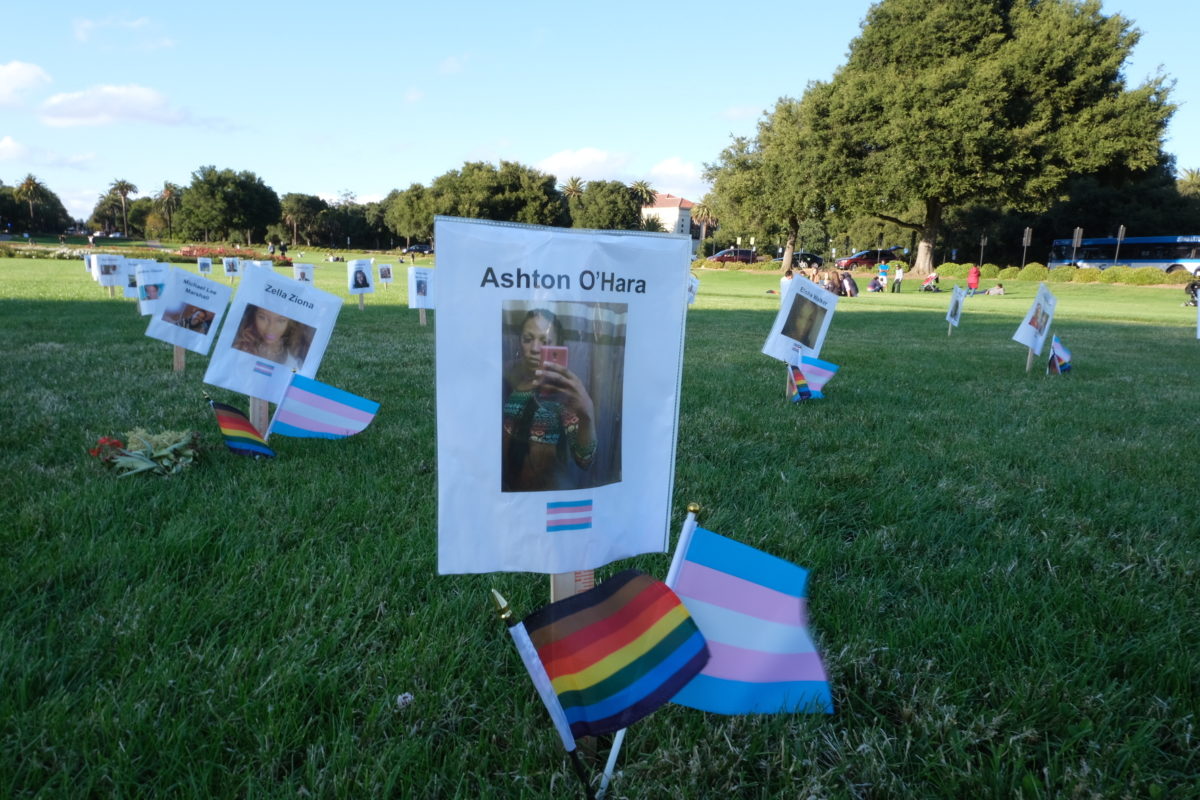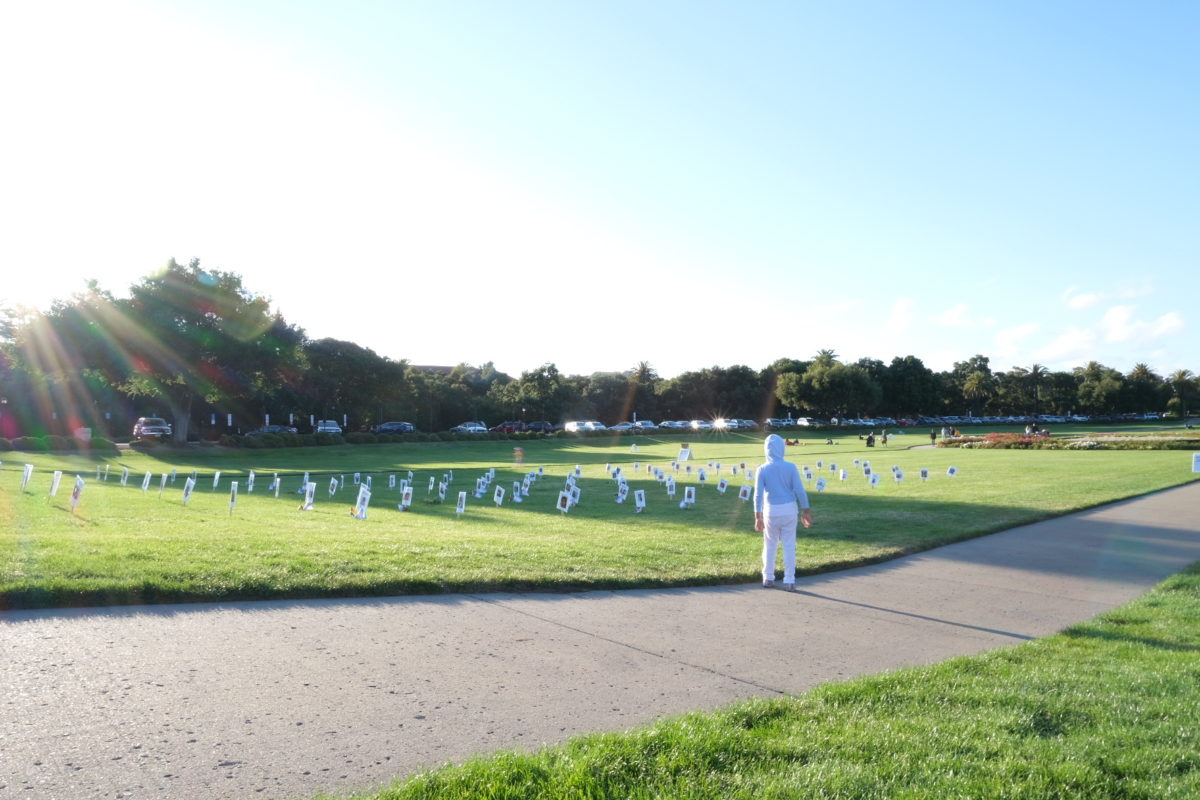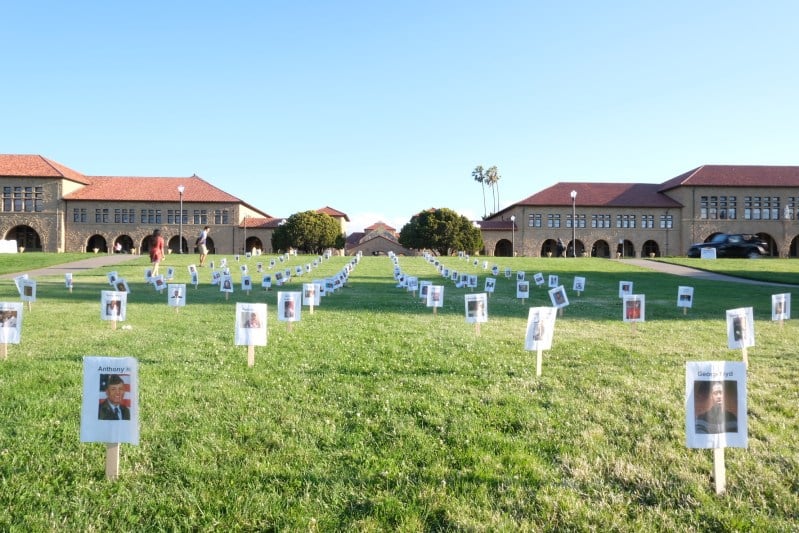A student-created memorial for Black lives now marks the Stanford Oval. The handmade signs form neat rows across the grass, each bearing the name and face of a Black person killed by racial violence and police brutality.
The memorial is a physical reminder of the community organizing taking place in the form of public marches, online fundraising, and virtual coalition-building in the wake of the death of George Floyd, a Black man who was killed by police in Minneapolis, Minnesota, in May.
The memorial was organized by three Stanford students, who requested anonymity so as to center attention on the Black names featured in the memorial. On Wednesday night, the students hammered stakes into the grass and taped up more than 100 signs, protected from sprinklers by plastic sleeves.
“The memorial serves as a physical space to simultaneously celebrate Black lives, and mourn Black deaths, in a way that encourages our local community to continue to address the pervasiveness of racial violence,” one organizer told The Daily.
George Floyd, Breonna Taylor and Ahmaud Arbery are in the memorial.
So too is Tanisha Anderson, who wears a graduation cap in her photo, and peers out at students who walk by in theirs at year-end.
So too are Akai Gurley and John Crawford III, who smilingly cradle infants in their photos.
The organizers selected names for the memorial from police brutality and shooting databases. Photos were often those released by the families of the victims.
“Finding photos made me realize how young so many of them are — in prom outfits, or what looks like high school graduation photos,” said another organizer of the memorial.
For him, reading Natasha McKenna’s story was most moving.
“Natasha McKenna was diagnosed with schizophrenia and bipolar disorder at age 12,” the organizer said. “She died at age 37 from being excessively tasered while in prison after having a ‘mental health episode.’ Having diagnosed bipolar disorder myself, her experience reminded me of our society’s severe lack of empathy for mental health issues … Her death never received justice of any form.”
The idea for the memorial took shape amid final exams, during which the organizers sought input from Stanford’s Black Student Union, Black Graduate Student Association, the Stanford University Minority Medical Alliance and various student activists.
“We felt that it would be wrong to proceed with this demonstration without seeking input from Black leaders on campus,” said one organizer.
The organizers credit Jamayka Young ’21, president of Stanford’s Black Student Union, for suggesting that the memorial specifically highlight trans women because of the disproportionate violence they face. The organizers created two rows in the memorial dedicated to trans or gender nonconforming lives lost.
Nizah Morris, Claire Legato and Dana Martin are among the trans women with memorials in these rows, which were adorned with trans and LGBTQ pride flags by members of the public in the days following the memorial’s creation.
In 2019, the Human Rights Campaign reported the deaths of at least 26 transgender or gender non-conforming people due to fatal violence, the majority of whom were Black women. Similar numbers were reported in 2018.
“Trans POC stories were tough to read because every article cited names of other trans women murdered, not by police but as victims of street crime, and so on and so on. The scale of it wasn’t lost on me,” said one organizer.

The physicality of the memorial also serves as an introduction. At the memorial, a child asked her father, “Can I walk there?” Another child pointed to the signs: “Who are all these people?”
Having a physical space to engage with the lives lost, given social distancing, is particularly moving for some Stanford students.
“I relearned the complicated story of Sandra Bland: she was pulled over for a traffic violation and ended up alone in jail, unable to make bail, and three days later she was dead,” said Daryn Longman ’22. “In medicine, this would be a case of lethal negligence if not outright harm. That woman needed a social worker, a mental health professional or a friend, not a jail cell.”
Some passersby walk the grass rows of the memorial, stopping at turns to observe. Others kneel to take photos. Still others bring flowers.
“I’m thankful those still on campus could create a memorial that shows the physical mark that’s been left in our community,” said Emily Pang ’23.

Contact Yasmin Rafiei at yrafiei ‘at’ stanford.edu.
